Legacy of mesoamerica exam 1
1/383
There's no tags or description
Looks like no tags are added yet.
Name | Mastery | Learn | Test | Matching | Spaced |
|---|
No study sessions yet.
384 Terms
The characteristics of mesoamerica (Kirchoff 1943)
Economic Traits:
Maize, Beans and Squash
Obsidian Tools
Plaster in Architecture
Market Exchange
Political Characteristics:
Large Monumental Centers
The Mesoamerican Ballgame
Religious Practices:
Shared Pantheon of Gods
Ritual Importance of Blood Sacrifice
The Number 13
Common Ritual Calendar
Ritual Importance of Cyclical Astronomic Events
Carmack et al’s definition of mesoamerica
A particular historical tradition of Indigenous cultures, or “civilization.”
Constantly undergoing change (before, during and after Colonial contact).
A complex mixture of regional and local cultures.
A cohesive legacy of cultural tradition.
Never politically or linguistically unified.
What do we call the people? Self-identity and “Mesoamericans”
When referring to the region in a scholarly way, we may call them “Mesoamericans”—but that is not what they call themselves
Most peoples self-identify as members of an ethnic group (Mayas, Nahuas) or local community (Chamulas, Zinacantanecos)
The words “Indian” and “Ladino” are highly charged, with specific meanings from Colonial history
Use these only when referring to historical documentary sources.
We will talk about the history of these words, and their meanings in colonial and modern activist contexts.
Generally, it is ok to specify if someone identifies as “Indigenous” or not.
Defining Mesoamerica—culture and politics
It is important to recognize that most of Mesoamerica was never politically unified.
Even the Aztec Empire, the Tarascan Empire and the Mayapan confederacy (the largest political entities prior to European contact) never controlled the whole region.
During the Colonial period, the region was partially unified under “New Spain,” but was sub-divided into vice-royalties of New Spain, Soconusco, Guatemala and Yucatan.
The modern country of Mexico was mostly formed following the end of the Mexican War of Independence in 1821, but never included Guatemala, Belize, Honduras or El Salvador
Major language families of Mesoamerica
• Nahua, 3
Nahua, Pipil
• Tarascan, 1
• Totonacan, 2
• Cuitlatecan, 1
• Hokan, 2
• Huave, 1
• Mixe-Zoquean, 9
Zoque, Mixe, Popoluca
• Oto-Manguean
Mixtec, Zapotec, Chatino, Trique
• Mayan, 29
Yucatec, Tzotzil, Tzeltal, Chol, Chorti, K’iche’, Kakchiquel, etc.
Lowlands (tierra caliente)
Lowlands (Tierra Caliente)
Hot, humid
Tropical Rain Forest
0-1000 masl
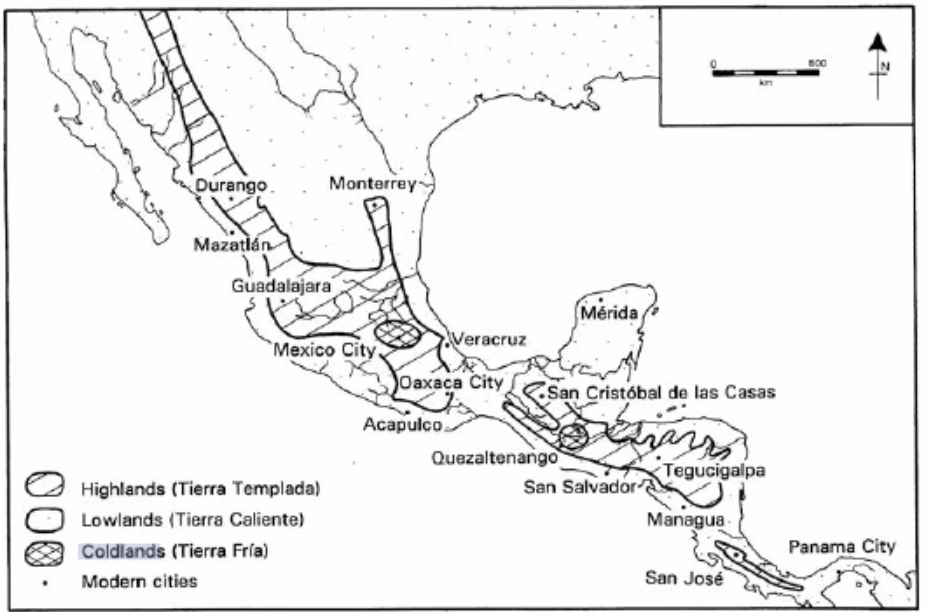
Highlands (tierra templada)
Highlands (Tierra Templada)
Temperate, arid
1000-2000 masl
A.2 figure also look A.3
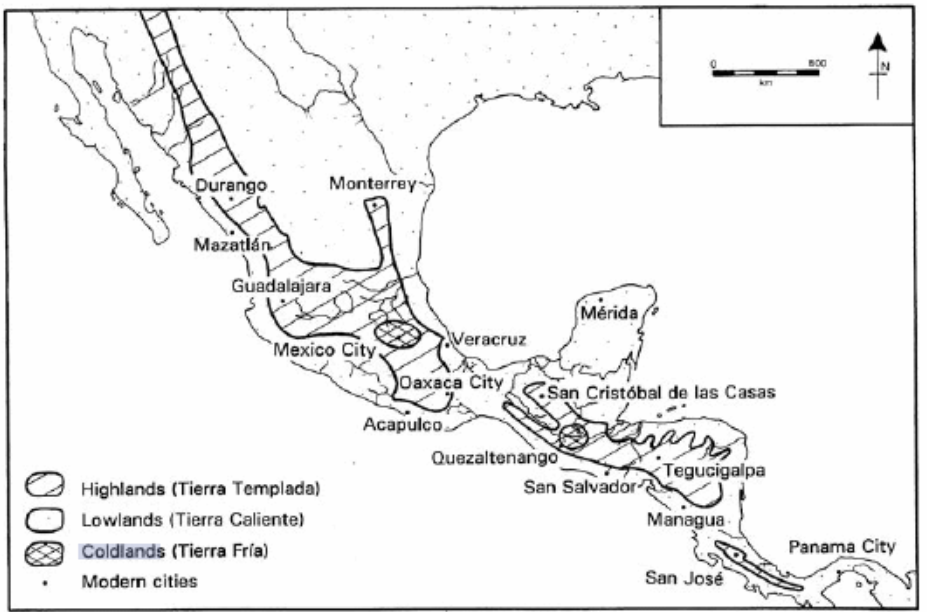
Coldlands (tierra fria)
Coldlands (Tierra Fria)
Cold
Over 2000 masl
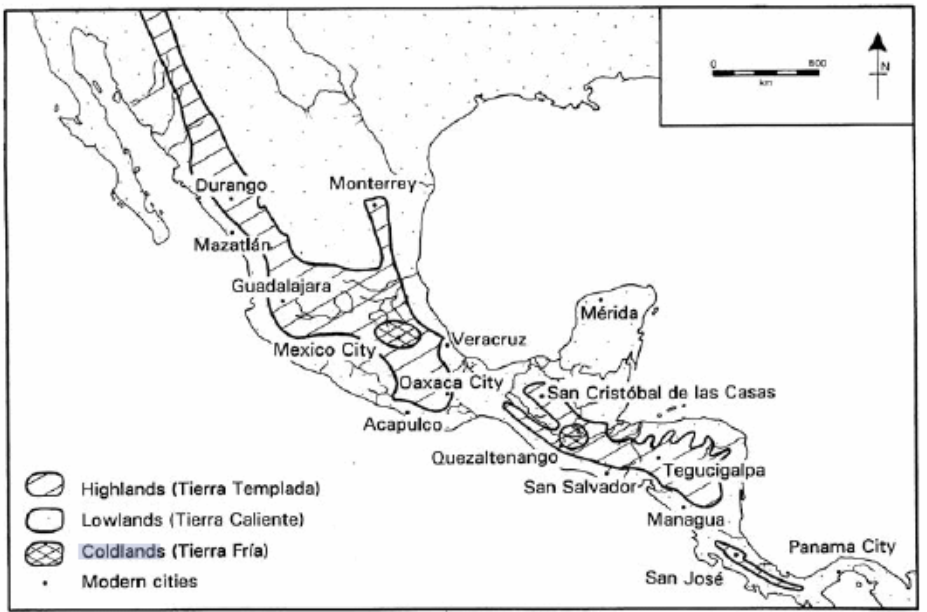
Why does geography matter?
Climate (altitude, rainfall and humidity) affects the length of the growing season and the types of crops that you can grow
Lowlands could grow more food, and often supplied food to the highlands. They also had specialty crops (cacao, vanilla) and tropical animal species.
Highland areas had specialized mineral resources (volcanic stone and ash, precious stones, metal ore), pine and oak timber, and maguey plants.
Coastal areas and natural springs had salt and marine shell
Growing seasons
Climate (altitude, rainfall and humidity) affects the length of the growing season and the types of crops that you can grow
Lowlands could grow more food, and often supplied food to the highlands. They also had specialty crops (cacao, vanilla) and tropical animal species.
Geography and natural resources (plant species, animal species, crops, minerals) in different climates
Highland areas had specialized mineral resources (volcanic stone and ash, precious stones, metal ore), pine and oak timber, and maguey plants
Coastal areas and natural springs had salt and marine shell
The “three sisters”
In most areas of Mesoamerica, the “Three Sisters” dominated staple agriculture
Corn, beans and squash
Milpa farming/ multicropping
Milpa farming (multicropping)
Highlands—Terrace farming
Coastal lowlands/rivers—Raised-field agriculture
The distribution of valuable raw materials
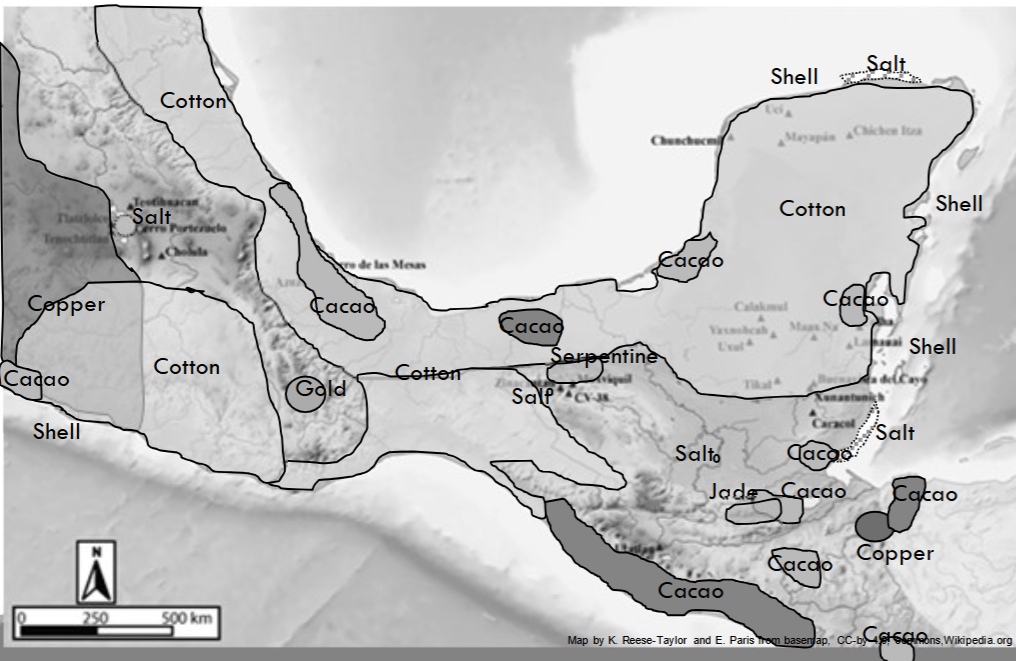
Highlands vs. lowlands and environmental determinism
Sanders and Price (1968) ecological model (reflected in your book)
Environmental determinism
Highlands
Heterogenous resource distribution
Arid environment suited to intensive agriculture
Bounded territories
Lowlands
Homogeneous resource distribution
Landscape amenable to slash and burn agriculture
Less bounded physical landscape
Critiques of the ecological model/ new perspectives
We now know that the ecological model is incorrect—lowlands had cities and heterogeneous resources
Why were they wrong?
Archaeologists like large, grid-plan cities
Tenochtitlan, Teotihuacan
Tropical environments are hard to survey on foot
New LiDAR survey can document the size of lowland cities
Ecological models were based on assumptions developed for the Near East
More written sources are available for central Mexico
Conquest of Tenochtitlan
Preservation of documents in arid vs. tropical climates
Geographic regions (know its location, major geographic features, important sites associated with it, climate, important plants/animals/crops, types of agriculture, etc)
Northern Highlands
Central Mexico, including the Basin of Mexico, highland Oaxaca and Guerrero
Lies between the Sierra Madre Occidental (W) and Oriental (E)
Volcanoes, highland plateaus, lakes and basins
Supported many large cities from the Classic period onward
Arid highland climate, pine-oak forest
Cloud forest at high elevations
Cacti, grasses and scrub oak at low elevations
Terrace farming
Maguey
Highland fauna
Deer, dogs, turkeys, rabbits, pumas, lake resources Terrace farming
Xoloitzcuintle dogs
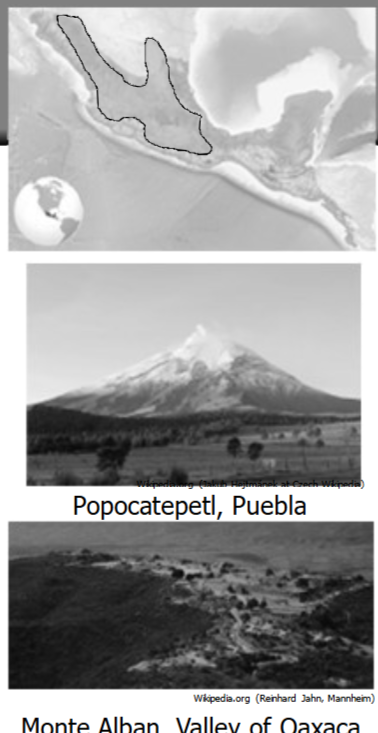
Northern Mexico Dry Lands
Northern Mexico between the Sierra Madre Occidental (W) and Oriental (E)
High desert basins with daytime-nighttime temperature swings
Important transportation corridor between Mesoamerica and Puebloan peoples
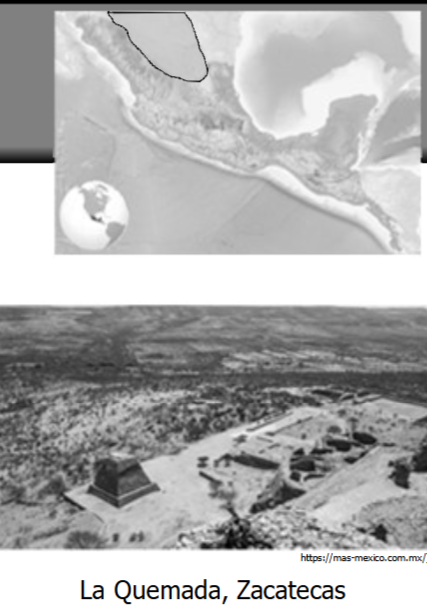
Gulf coast lowlands
Hot, humid, tropical grasslands and tropical forests, lots of rivers
Lagoons and tidal swamps
Hardwood, palm, rubber, fruit trees
Cacao and vanilla
Tropical forest and coastal fauna
Monkeys, sloths, coatis
Tapir, peccaries, brocket deer
Tropical birds and waterfowl
Fish
Important coastal trade route
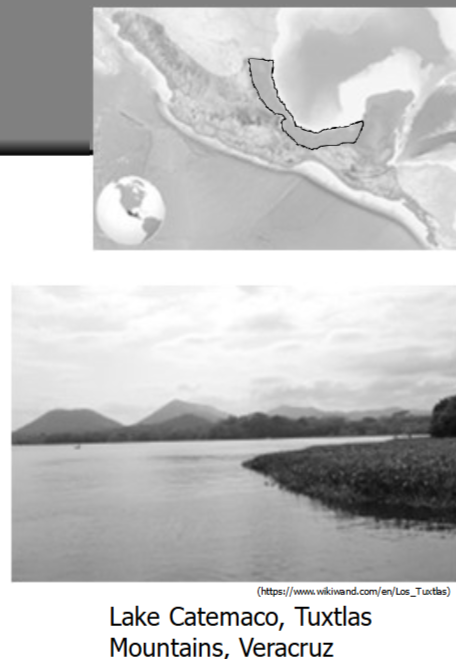
Pacific coast lowlands
Hot, humid, tropical plains, mangrove forests, river valleys
Pacific Coastal Chiapas is known as the Soconusco (from the Aztec province of Xoconochco)
Defined to the west/north by the Sierra Madre Occidental
Distinct rainy-season dry-season climate
Huge cacao production from ancient to modern times
Important coastal trade and migration route
Tropical forest and coastal fauna, similar to Gulf Coast
Includes soconusco:
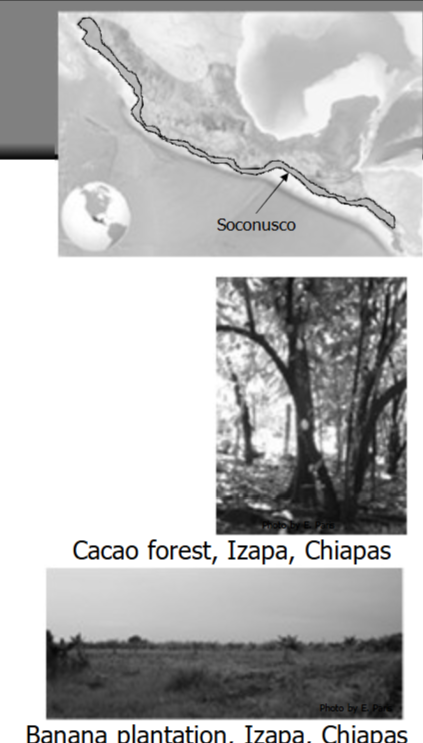
Southern highlands
Highland Chiapas and Highland Guatemala
Central Plateau of Chiapas + the Cuchumatanes Mountains + Sierra Madre Occidental
Volcanoes, highland plateaus
Intermontaine plateaus and basins are smalll compared to Central Mexico
Highland climate, pine-oak forest
Cloud forest at high elevations
Less arid than Central Mexico
Rainy season-dry season
Terrace farming
Maguey
Highland fauna + Tropical fauna at mid- range elevations
Tapir
Jaguar
Quetzal
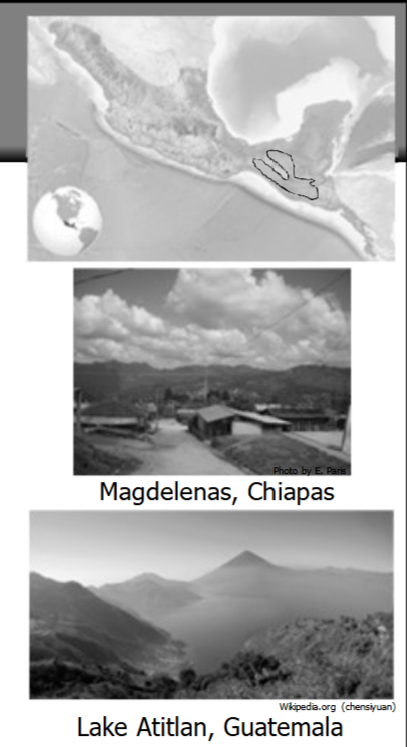
Southern maya lowlands
Hot, humid, tropical forest, seasonal swamps (bajos), some river valleys
Home to Maya political capitals during the Classic period
Distinct rainy-season dry-season climate
Tropical forest fauna
High plant diversity
Fragile soils
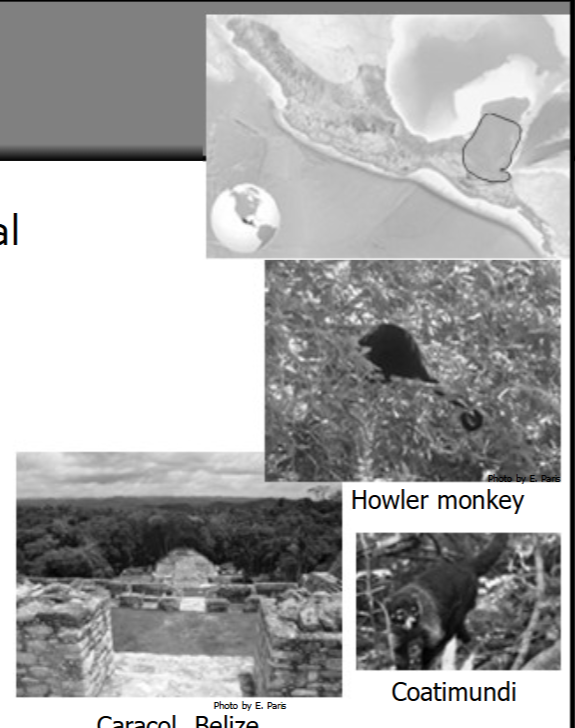
Bajos
Seasonal swamps that flood during the rainy season (May-Nov)
“Bread basket” areas for water-intensive crops due to rich soils
Concentrations of rural settlement
Intensive wetland agriculture
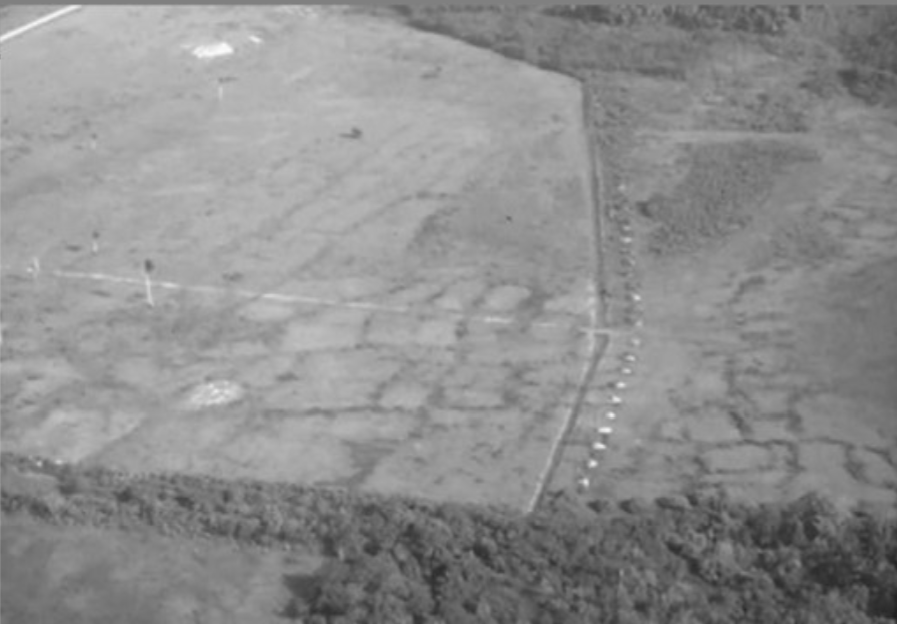
Karst formations
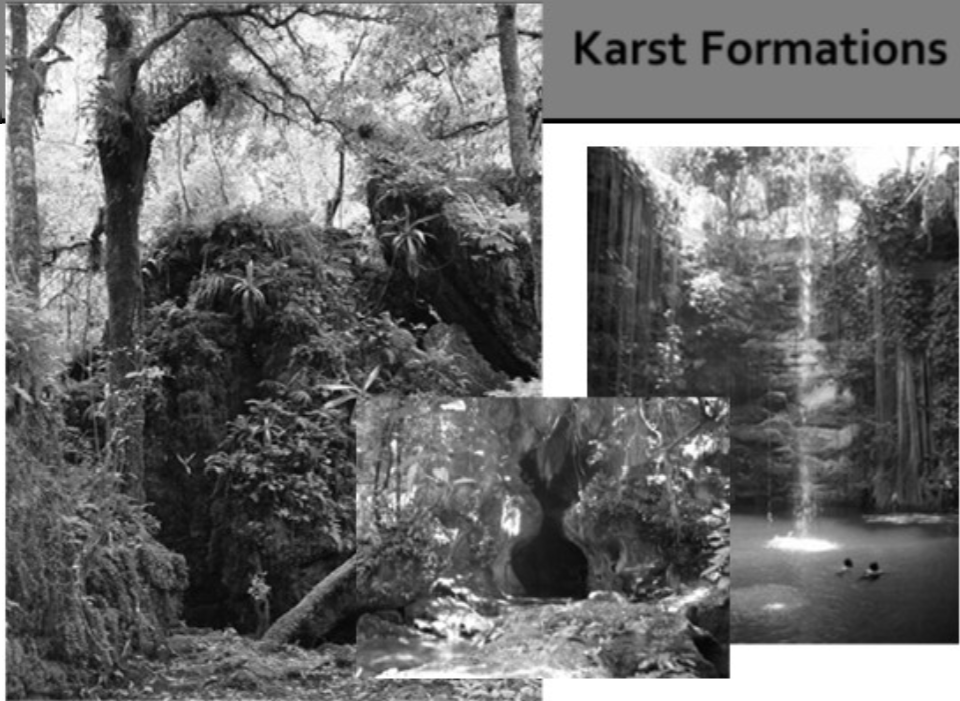
Northern maya lowlands
Hot, semi arid, tropical dry forest
Mangrove swamps, coastal beaches, and salt flats along the coast
Hoem to maya political capitals during the postclassic period
Coastal trade routes
Distinct rainy-season dry-season climate
Cenotes (sinkholes) and karst topography
Tropical dry forest fauna
Thin soils
Deer, dogs, iguanas, stingless bees
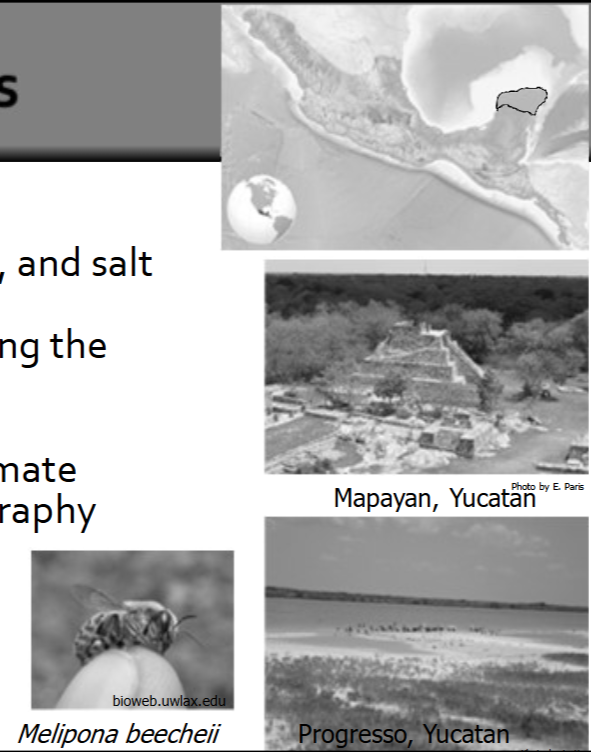
Mangrove swamps
Rainfall patterns in the Maya culture area
Greater rainfall in the Southern Maya Lowlands
Rainy season-dry season Pattern
Tendency towards droughts
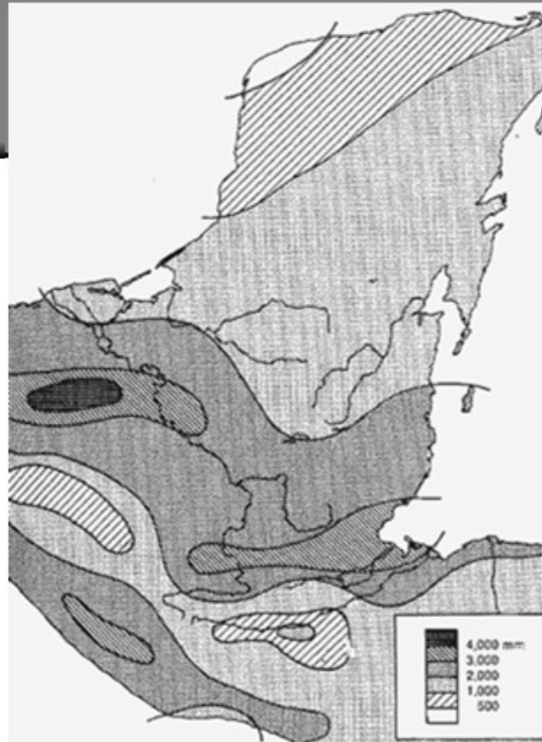
Archaeology
Able to document a wide range of activities and lived
experiences
Relative and absolute (Carbon 14) dating
Not all activities can be preserved though archaeology
Organics destroyed through decay in tropical environments
Erosion, continuing occupation of the land, looting
Need to exercise caution in interpretations—we cannot know peoples thoughts and feelings from material culture
Biological anthropology
Bioarchaeology- study of human remains
Paleodemography- reconstructing population growth and mortality in past societies
Epidemiology of nutrition studies of modern Mesoamerican peoples
Bioarchaeology
Bioarchaeology can document a lot of aspects of ancient life:
demographic factors
ancient diseases
diets
health
warfare
Human bone has preservation issues in the archaeological record:
Burial conditions—pit vs. tomb vs. cave
Tropical vs. dry climates
Cultural anthropology
The analysis of human culture and social life, typically focusing on modern peoples.
Ethnography: The scientific description of the customs of individual peoples and cultures.
Ethnoarchaeology: The study of modern populations to answer methodological questions about traditional lifeways in the study of past populations
Ethnoarchaeology
Many cultures preserve the traditions of their ancestors
Cross-cultural analogies based on environment, complexity, technology
However:
Traditions change a lot in 500 years
Indigenous traditions mixed with European influences over 500 years
Linguistic Anthropology
Historical linguistics--The reconstruction of past languages
Epigraphy—The decipherment of hieroglyphic writing
Language often holds clues to:
Populations movements and relationships
Cultural practices
Cognitive concepts
However:
Language also changes over time
Many languages have loan words
Cognitive concepts can change over time
Relationships between groups also change over time
History
History: The study of the human past through written records
Includes: Indigenous documentary texts, languages, and oral histories
Carved objects with texts
Stone monuments, portable objects (stone, shell, ceramic)
Pictoral codices
Colonial period codices and documents
Books of the Chilam Balam
Accounts by Spanish conquistadors and friars
Legal documents and church records
Codex (codices)
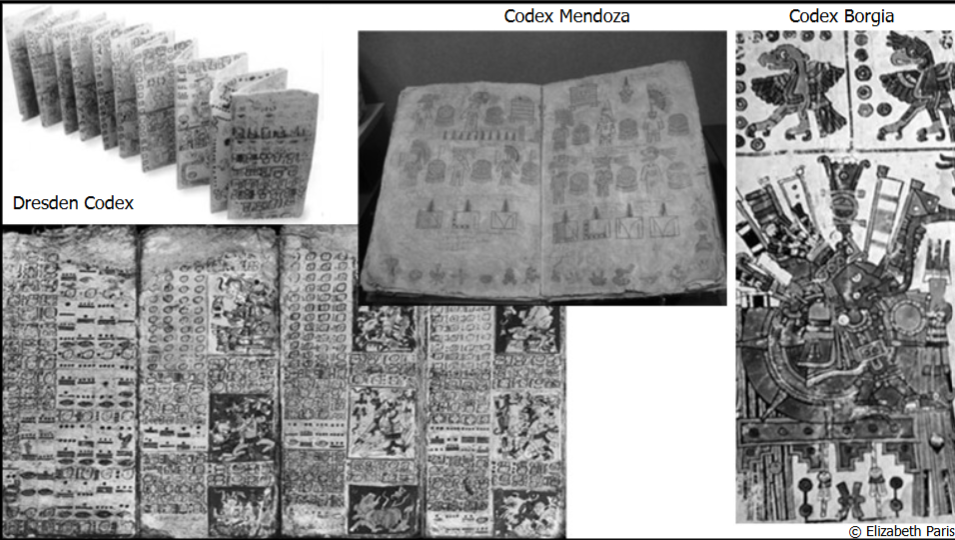
Ethnohistory
Reports of the Spanish conquistadors
Hernan Cortes
Diego de Godoy
Bernal Diaz del Castillo
Other Spanish chroniclers: Friars often compiled documents describing aspects of Indigenous life
Diego Durán
Fray Bernadino de Sahagún
Bishop Diego de Landa
Bishop Bartolomé de Las Casas
Maya codices
Aztec codices
Mixtec codices
Books of the Chilam Balam
17th-18th centuries
Written in small towns in Yucatan state
9 total
Chumayel (Canul)
Mani (Xiu)
Tizimin (Cocom)
Written in Yucatec Maya using a Latin alphabet
Religious prognostications, political history, medicine
Fray Bernadino de Sahagún
14 volume chronicle, covers lots and lots of stuff- had sons of nobility (kidnapped?) and would just get them to tell them about various things, draw a picture and then write about it
wrote the florentine codex
mexico area?
mexica/ aztec codex
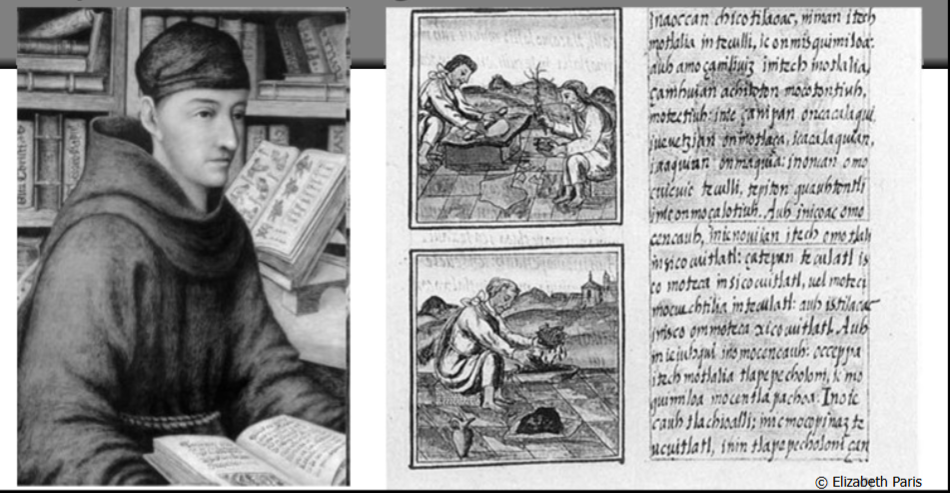
Bishop Diego de Landa
• Auto de fe of Mani, 1562
• Burned 27 codices
Bit extreme- believed it was his duty to stamp out idolatry (lots of torture). Dis it so much he actually got in trouble with spanish authority. Got dragged back to spain to answer for his actions (usually only done in extreme circumstances)
Prepared justification of his actions as part of his defense to the spanish court- did it in association with a young man from one of the first “royal”(?)families to convert to catholicism. Ended upo helping to crack code of maya hieroglyphics
Got the guy to write down consonant vowel pairs corresponding with a symbol- they didnt understand it, but eventually people did.
wrote Relacion de las Cosas de Yucatan (An account of the things of the Yucatan)- account of maya culture
Relacion de las Cosas de Yucatan (An account of the things of the Yucatan)
written by diego de landa
Bishop bartolome de las casas
A short account of the destruction of the indies
Historia de las indias
Appalled by actions of spanish in cuba, converted to priesthood. Went back to spain and studied, got sent back to chiapas to try to convert indigenous peoples
Kept documenting atrocities by spanish conquistadors in chiapas- wrote accounts defending rights of indigenous peoples.
Not perfect! Quite racist against black people and enslaved africans brought by spanish
Historical records
Native chroniclers working under spanish friars- oftensons of indigenous nobles
Codex ixtilxochitl
Don fernando de Alva ixtlilxochitl
Often told from the perspective of indigenous elite of a very particular cultural group- Aztecs vs. Tlaxcalan perspective of the conquest
Relaciones (mexico)
Created by colonial administrators for administrators for tax purposes- very specific types of information, from an outsider perspective, several years after the conquest
Codex Ixtlilxochitl
Don fernando de Alva ixtlilxochitl
written by
The Relaciones (Mexico)
Created by colonial administrators for administrators for tax purposes- very specific types of information, from an outsider perspective, several years after the conquest
Historical records
Past studies of mesoamerica
Romanticists
Early scientific approaches
Culture historians
Processual Approaches
Postprocessual Approaches
Early scientific approaches
Fields of Study
Archaeology
history
Art History
Epigraphy
Research Goals
Develop Chronology
Document Architecture and Texts
Unclear Research Objectives
“Romanticism” and pseudoscience
Alexander von Humboldt (1769 –1859)
Prussian geographer, explorer and naturalist
Travelled extensively in the Americas from 1799-1804
Central Mexico, Peru, Venezeula, Cuba
Published a portion of the Dresden Codex (Maya) and illustrated monuments such as the Aztec Stone of the Sun
Stephens and Catherwood
1839-1842 explorations
Correctly Attributed Ruins to Ancestors of Contemporary Maya
Incidents of travel in yucatan (book name)
Alfred Maudsley
British diplomat and archaeologist (1850-1931)
Translation of Bernal Díaz del Castillo's “Historia verdadera de la conquista de la Nueva España” from the only original manuscript in 1908
Conducted excavations, mapping and photography at major Maya sites
Quirigua, Copan, Tikal, Palenque
Plaster casts of stela and monuments
Drawings of inscriptions
Early Institutions in Mexico
Wealthy Mexican nobles began collecting Aztec sculptures by the late 18th century
The first Cabinet of Curiosities of Mexico was established in 1790 by botanist José Longinos Martínez.
In 1825, the first president of independent Mexico, Guadelupe Victoria, established the National Mexican Museum
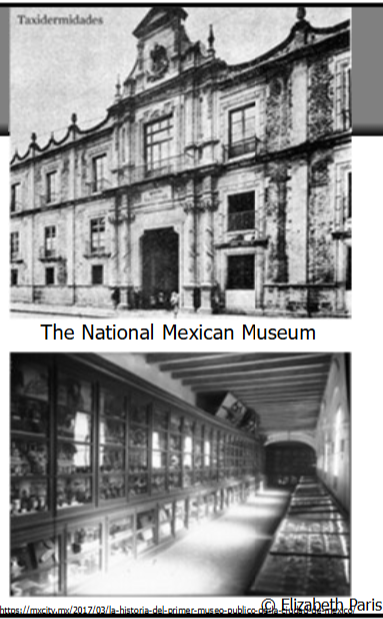
Culture history
the description and chronological and spatial ordering of archaeological data, became the sole objective of archaeological research and it remained so until the 1950s.
Interpretation consisted primarily of description of the diet, technology, migrations, and lifeways of past societies.
Leopoldo Batres
Leopoldo Batres (1852-1926)
A Mexican noble and former army officer
Worked as an archaeologist for the Museo National de Antropologia in 1884-88
Conducted excavations at Teotihuacan, but is highly criticized for some things
Used dynamite to speed up excavation
Removed and sold sheet mica from the temple façade
Reconstructions distorted the shape and size of the pyramid
Also worked at Monte Alban, Mitla, La Quemada, Xochicalco and Isla de Sacrificios
Alfonso Caso
Began his career as a lawyer and professor at UNAM, but his career was changed through a visit to Xochicalco
Rejected diffusionist arguments for the development of Mesoamerican civilization— emphasized continuity and internal evolution.
Famous for his work at Monte Alban, esp. The discovery of Tomb 7.
First director of INAH In 1939 (Instituto National de Antropologia e Historia)
Frans Blom
Danish archaeologist and explorer, 1893-1963
Went to Harvard after becoming interested in archaeology while working in Chiapas for the rubber industry in the 1920s
Founded the Middle American Research Institute at Tulane University
Led numerous “expeditions” to rural Chiapas to map and photograph sites in the 20s
First map of
Moved to Mexico in the 1950s
Excavations in highland Chiapas
Direct Historical Approach
Working backwards in time from historically known Indigenous peoples into prehistoric times.
Alfred Kidder – Guatemala
Alfred Tozzer– Translation and interpretation of Diego de Landa
Kent Flannery and Joyce Marcus – Zapotec religion
J. Eric S. Thompson
Dominated Maya studies for nearly 60 years
Dominance of Carnegie Institution of Washington
Early Synthesis of archaeology and ethnohistory
Catalogue of Maya hieroglyphics
Bizarre analogies to Greek/Roman archaeology
Maya as non-complex, non-urban, mystic priests, “vacant ceremonial centres.”
in Maya epigraphy and political history
Tatiana Proskouriakoff
Maya hieroglyphics as historic texts, with named rulers, dates and chronologies
Talented artist—reconstruction drawings of Maya cities
Maya epigraphy and political history
Processual archaeology
Processual archaeology focuses on the cultural process and the explanation of culture change.
Hypothesis testing against competing explanations
Use of the Scientific method
Aimed to identify universal laws of cultural change and human behavior
Systems ecology—Cultures are combinations of different, interrelated components.
At its best, ushered in an era of scientific advances; at worst, bluntly environmental determinist
Systems ecology
Cultures are combinations of different, interrelated components
Postprocessual archaeology
Postprocessual archaeology
Meaning--Culture is interactive and constructed. Traditions must be constantly reinvented to persist.
Agency—Interested in individuals, not just groups.
Bias--Archaeologists often systematically neglect to investigate the past of minority groups such as women, ethnic minorities, and anonymous, often illiterate commoners—often called “people without history.”
Postprocessual perspectives in archaeology- Gender and farming
Robin 2006
Westerners (and Western scholars studying Mesoamerica) assume that farming was male work
Gendered labor is historically situated, and often changes over time
Ethnographies of 1940s Yucatan have been used as a scholary model for the entire history of Maya farming
Archaeological evidence from Chan Noohol, Belize
Intensive terrace farming of staple crops, tree groves and gardens
No visible gender divisions of space
Farming likely involved all ages and genders
Chan Noohol, Belize
Archaeological evidence from Chan Noohol, Belize of gender and farming stuff
Intensive terrace farming of staple crops, tree groves and gardens
No visible gender divisions of space
Farming likely involved all ages and genders
Chronology
• Paleoindian (~30,000 – 7,000 BC)
• Archaic (7000 – 2000 BC)
• Formative (2000 BC – AD 250)
• Classic (AD 250 – 900)
• Postclassic (AD 900 – 1550)
Paleoindian period
• Earliest current archaeological evidence of human migration to the Americas
• Big game hunting
• Clovis, Folsom, Cascade and other projectile points
• Mobile hunter-gatherer-fisher groups
30,000-7000 BC
Peopling of the Americas
• The Clovis-first hypothesis
• Argued that the Americas were originally populated by a single group of people from Siberia
• Hypothesized that they migrated through an “Ice-free corridor” between the Laurentide and Cordilleran Ice sheets
• Initial migration was hypothesized to have happened around 13.5 kya when the corridor was open
• Spread across North America, and eventually to South America around 13 kya
Big game hunting
mobile hunter gatherer fisher groups
Clovis, folsom, cascade and other projectile points
Projectile points (Clovis, Folsom, Cascade styles)
“Ice-free corridor”
The Clovis-first hypothesis
Argued that the Americas were originally populated by a single group of people from Siberia
Hypothesized that they migrated through an “Ice-free corridor” between the Laurentide and Cordilleran Ice sheets
Initial migration was hypothesized to have happened around 13.5 kyawhen the corridor was open
Spread across North America, and eventually to South America around 13 kya
The Coastal Hypothesis
• New discoveries suggest that there are a number of sites older than the Ice-free corridor
• Debra L. Freidkin site, Texas—pre- Clovis lithics dating to 13.5-15.5 kya
Lanceolate points with no evidence of the distinctive basal flute
• Gault site, Texas—9.3 kya
• Paisley Caves, Oregon—14.2 kya
• Page-Ladson site, Florida—14.6 kya
• Meadowcroft Rockshelter—14 kya
• Monte Verde, Chile—14.8 kya
Chiquihuite Cave, Zacatecas
• High-altitude cave site in central- northern Mexico
• Stone tools date back to the Last Glacial Maximum (26,500—19,000 BP)
• Pushes back human occupation in the region to 33-31 kya
• 1,930 stone artifacts in a 3 m deep stratified sequence
• Pre-dates Clovis culture
The footprints of White Sands National Park
White Sands National Park, New Mexico
• Fossilized footprints across fossilized ancient Lake Otero
• Former lake and grasslands that attracted megafauna such as
mammoths, ancient camels, giant sloths, dire wolves, and
American lions
• C14 dating of ancient grass seeds suggests they were created
21,000-23,000 years ago
Wasnt on study guide PSA
The Debra L. Freidkin site
Texas—pre- Clovis lithics dating to 13.5-15.5 kya
Lanceolate points with no evidence of the distinctive basal flute
Monte Verde
• Earliest deposits date to 33,000 BP—more controversial, contains charred animal bones, lithic artifacts, and possible hearths
• The upper level has more extensive artifacts and features, and dates to 14,800-13,800 BP
Artifacts and features of Monte Verde
• 20-foot long structure made from a wood frame with anumal hides
• Ropes made from local reeds
• Two communal hearths
• Many stone tools
• Spilled seeds, nuts, berries, wild potato, seaweed and other edible plants
• Human coprolites
• Human footprint
Mexico City airport discoveries
• Discovery of over 200 mammoths during the excavations for the new Mexico City airport in 2020
• 10000-20000 years old
• Trapped in lakeshore mud
• Also found 25 South American camels and 5 American horses
Clovis in Mesoamerica
• Early sites with pre-Clovis occupation in Mesoamerica, by 20,000 ya
Chiquihuite Cave, Zacatecas
El Cedral, San Luis Potosi
Tlapacoya, Basin of Mexico
El Bosque, Nicaragua
Clovis points have been found in a wide range of contexts
Fin del Mundo site in Sonora
Skeletal remains of two gomphotheres in association with Clovis-era deposits
Dates to 13,390 BP
Archaic period
~7,000-1300 BC
Cultural developments associated with the Archaic period
• Mobile foraging to sedentism
• Plant Domestication
• Agriculture
• Shell mounds and dry cave sites
• Diversification of stone tool kits
• Trapping of small game vs. hunting big game
• First pottery in Tehuacan (Central Mexico) at 2300 BC
Tehuacan Valley
First pottery in Tehuacan (central mexico) at 2300 BC
Guila Naquitz cave
Guilá Naquitz Cave has the earliest dated maize cob at 4300 BC
Tehuacán Valley maize cobs date to 3500 BC
Guilá Naquitz squash dates to 8000-6000 BC
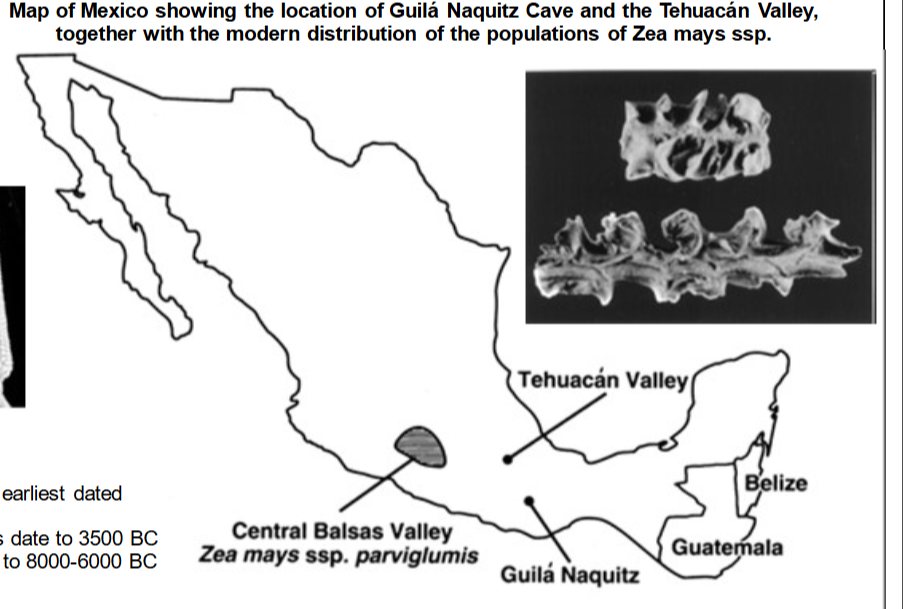
food????
-Maize (corn)
• Beans
• Squash (pumpkin)
• Squash (bottle
gourd)
• Manioc (yuca)
• Amaranth
• Cacao
• Avocados
• Chile peppers
Archaic-period Basin of Mexico/ Zohapilco site
• Zohapilco site, on the ancient shore of Lake Chalco
• Fully sedentary groups appear by 6000 BC
No seasonal mobility
• Transition from a foraging to production economy:
“Proto-agricultural”
Maize, amaranth and tomatillo
Occupation levels still contain a range of deer, Canid, rodent, turtle, fish and bird species
• Earliest ceramic anthropomorphic figurine known in Mesoamerica, 2300 BC
Archaic period stone tools
Early formative period
~1500-900
• Agriculture
• Pottery becomes widespread
• Social rank emerges (Chiefdoms)
• Population growth
• Specialized craft production
• Long-distance exchange
• Monumental sculpture and architecture
• Ball courts
Formative Period Sites
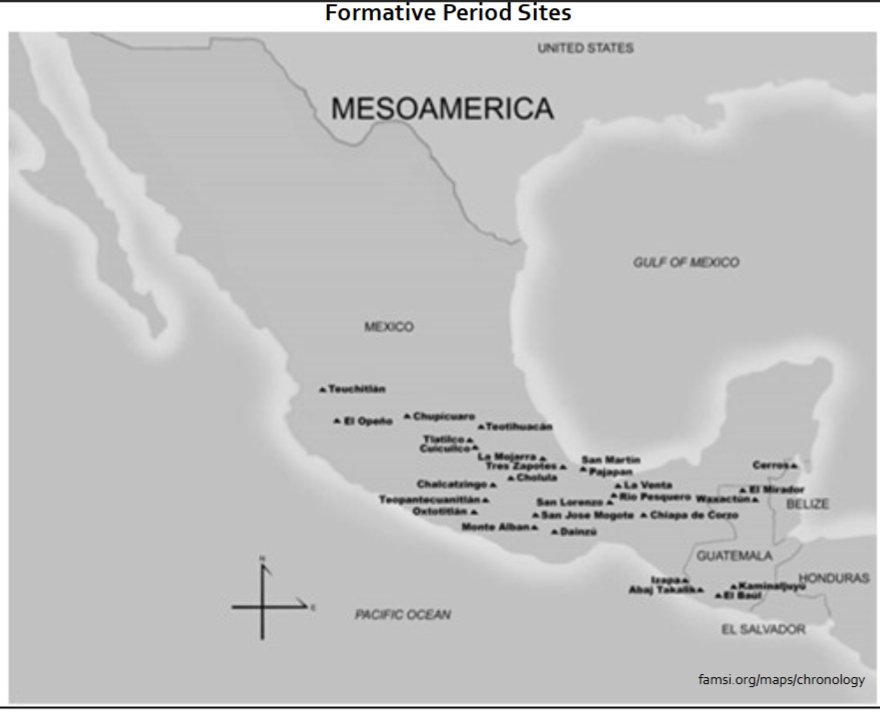
Pacific coastal shell mounds
Soconusco region
paso de la amada
More
Tlacuachero
Intensive shellfish harvesting
Seasonal fisher-horticulture
Earliest slash-and-burn farming
Abandonment of shellmounds
Cultural developments associated with the Early Formative period
• Agriculture
• Pottery becomes widespread
• Social rank emerges (Chiefdoms)
• Population growth
• Specialized craft production
• Long-distance exchange
• Monumental sculpture and architecture
• Ball courts
Paso de la Amada
• Soconusco Region
• Early Formative Village (2000-1000 BC)
• Earliest Pottery in Mesoamerica
• Public Architecture
Earliest ballcourt? according to internet- 1400 BC
Earliest ballcourt
at paso de la amada, 1400 BC